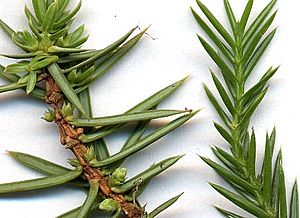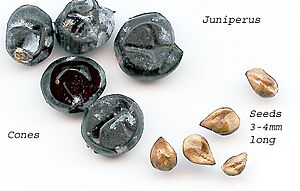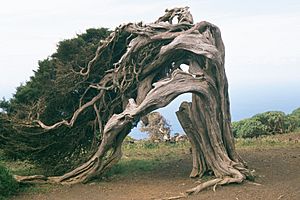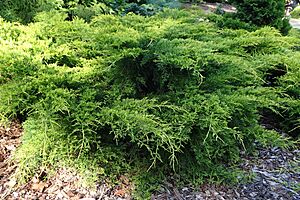Juniper facts for kids
Quick facts for kids Juniper |
|
|---|---|
 |
|
| Utah juniper (Juniperus osteosperma) in Nevada, United States | |
| Scientific classification |
|
| Kingdom: | Plantae |
| Clade: | Tracheophytes |
| Division: | Pinophyta |
| Class: | Pinopsida |
| Order: | Pinales |
| Family: | Cupressaceae |
| Subfamily: | Cupressoideae |
| Genus: | Juniperus L. |
| Type species | |
| Juniperus communis |
|
| Species | |
|
See text |
|
| Synonyms | |
|
|
Junipers are amazing trees and shrubs that stay green all year. They belong to the cypress family. There are about 50 to 67 different kinds of junipers. You can find them all over the Northern Hemisphere. They grow from the cold Arctic all the way down to warm Africa. They also grow across parts of Asia and in the mountains of Central America. The highest juniper forests grow in Tibet and the Himalayas. They are found at an amazing height of 4,900 meters (about 16,000 feet). This makes them one of the highest tree lines on Earth!
Contents
What are Junipers Like?
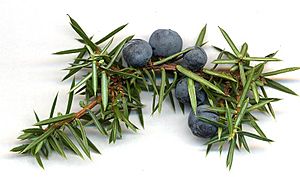
Junipers come in many shapes and sizes. Some are tall trees, reaching 20 to 40 meters (65 to 130 feet) high. Others are low-growing shrubs with long, spreading branches. Their leaves are always green. They can be either needle-like or look like tiny scales.
Junipers have special cones that are very unique. The female cones are soft and fleshy. They look like small berries. These "berries" can be 4 to 27 millimeters (about 0.15 to 1 inch) long. Inside, they hold one to 12 hard seeds. Most juniper "berries" are blue, but some can be red-brown or orange. They often smell nice and can be used as a spice! It takes 6 to 18 months for the seeds to ripen after pollination. The male cones are smaller and have 6 to 20 scales.
In warmer areas, junipers can bloom and release pollen many times a year. Some bloom in autumn. Most release their pollen from early winter until late spring.
Juniper Leaves
Many junipers have two kinds of leaves. Young plants and some branches on older trees have needle-like leaves. These needles are 5 to 25 millimeters (about 0.2 to 1 inch) long. On older plants, the leaves are usually tiny scales. These scales are only 2 to 4 millimeters (about 0.08 to 0.16 inches) long. You might see needle-like leaves on shaded parts of older trees. The scale-like leaves grow where there is lots of sunlight.
Some juniper types, like the common juniper, only have needle-like leaves. These needles are usually stiff and sharp. This can help you tell them apart from other similar plants. For example, young cypress trees have soft, not prickly, leaves.
Junipers are gymnosperms. This means they have seeds but no flowers or fruits. Their seeds can take 1 to 3 years to grow. The seed coat is very tough. This protects the seed and keeps water out. This tough coat can also make the seed stay dormant for a long time. Animals that eat fruits can help spread juniper seeds. The seeds can pass through their digestive system without being harmed. This helps junipers spread their seeds far and wide.
How Junipers are Grouped
Scientists group junipers into different sections. This helps them understand how the species are related. One way to group them is based on their genes.
Main Sections of Junipers
- Section Caryocedrus
* This section has only one species. * Its cones are large, blue, and woody. * They have three seeds that are fused together. * This juniper is found in the Mediterranean area.
- Section Juniperus
* This section includes 14 species. * Their cones are blue or red. * They often have three seeds. * Most are found in the Eastern Hemisphere. One species, J. communis, grows all around the northern parts of the world.
- Section Sabina
* This is the largest section, with about 60 species. * Their cones come in different colors. * They can have 1 to 13 seeds. * Species in this group are found in both the Eastern and Western Hemispheres.
Examples of Juniper Species
Here are a few examples of junipers from different parts of the world:
- Juniperus communis – This is the most common juniper.
- Juniperus chinensis – Known as the Chinese juniper.
- Juniperus virginiana – Often called eastern redcedar in North America.
- Juniperus osteosperma – A juniper found in the western United States.
- Juniperus phoenicea – Found in the Mediterranean region.
Juniper Habitats and Wildlife
Juniper plants can grow well in many different places. For example, in the Lahaul valley, you can find junipers growing in dry, rocky areas. These plants are very important to local people and animals.
Western juniper plants often grow in open woodlands. They like open spaces so they can get more rainfall. Sometimes, junipers can spread a lot. This can change the environment for other plants and animals. For example, if junipers grow too much, there might be less space for other woody plants like sagebrush. When there are too many junipers, they compete with each other. This can lead to fewer juniper "berries" being produced.
Some junipers can get a disease called Gymnosporangium rust. This disease can also affect apple trees. So, if you grow apple trees, you might need to watch out for this disease on nearby junipers.
Juniper plants are also food for the larvae (young) of some moths and butterflies. For example, the juniper carpet moth and the pine beauty moth eat juniper leaves.
Growing Junipers
Junipers are very popular plants for gardens and parks. People have grown them for many years. They have created many different types of junipers. These types vary in color, shape, and size. Some are very tiny, like miniature plants. Junipers are also used to create bonsai trees.
Here are some popular juniper species grown in gardens:
- Juniperus chinensis (Chinese juniper)
- Juniperus communis (Common juniper)
- Juniperus horizontalis (Creeping juniper)
- Juniperus procumbens (Ibuki juniper)
- Juniperus scopulorum (Rocky Mountain juniper)
Juniper Pollen and Allergies
In dry areas, juniper pollen can easily blow in the wind. If you breathe in this pollen, it can sometimes irritate your lungs. It can also cause a skin rash for some people. If you are allergic to juniper pollen, you might also be allergic to cypress pollen.
Some juniper plants have both male and female parts. These can cause more allergies. Male juniper plants release a lot of pollen. They are considered very allergenic. Female juniper plants, however, produce very little pollen. They are considered "allergy-fighting" plants.
Uses of Junipers
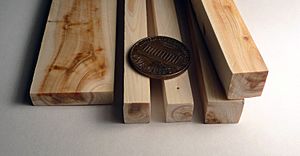

Traditional and Cultural Uses
Many types of juniper wood are strong and flexible. Native American cultures in the Great Basin region used juniper wood to make hunting bows. They often added animal tendons to the bows to make them even stronger.
Ancient people in Mesopotamia believed that juniper oil could protect them from bad luck. Juniper oil was also found in old Egyptian burial chambers. This shows it was used in embalming.
Some Indigenous peoples of the Americas use juniper in their traditional medicine. For example, the Navajo people have used it for diabetes. They also used juniper ash as a source of calcium.
In Scotland, people traditionally burn juniper branches. They use the smoke to cleanse and bless their homes. This is often done during New Year celebrations. People in the Lahaul Valley in India also use juniper leaves in their religious traditions. They believe it helps with pains, aches, and even epilepsy.
Everyday Uses
Juniper "berries" are a popular spice. They are used in many dishes. They are most famous for giving gin its special flavor. In fact, the name "gin" comes from the Dutch word for juniper, jenever. You can also make a type of brandy from fermented juniper "berries". Juniper "berry" sauce is often used with game meats like quail, venison, and rabbit. You can even make a tea from young juniper twigs.
Juniper wood is strong and resists rotting. Because of this, it has been used for fence posts and firewood. Some junipers, like the eastern redcedar, are used to make cedar drawers and closets. The wood has a nice smell and helps keep bugs away.
Juniper wood can also be used as a type of outdoor siding for buildings. This is a traditional building method in Northern Europe. Juniper "berries" are also used to make essential oil. This oil is used in perfumes and other products.
Images for kids
-
Juniperus grandis in the eastern Sierra Nevada, Rock Creek Canyon, California
-
Juniperus virginiana in October with ripe cones
See also
 In Spanish: Enebros para niños
In Spanish: Enebros para niños



